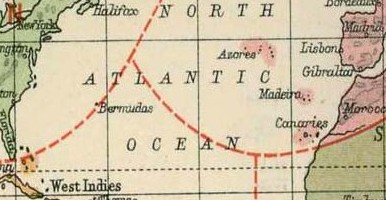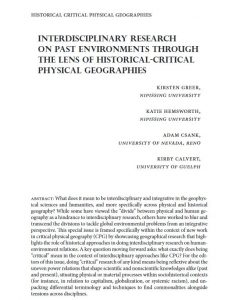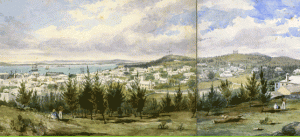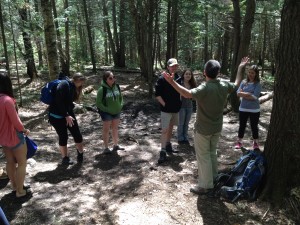An important aspect of my research is to foster boundary-crossing between human and physical geographies – and the humanities and physical sciences more generally – through historical and critical physical geographies.
A SPECIAL ISSUE ON HISTORICAL-CRITICAL PHYSICAL GEOGRAPHY WAS PUBLISHED IN HISTORICAL GEOGRAPHY IN 2018
The special issue included an article on the historical geographies of interdisciplinarity through the histories of McGill University’s Caribbean Project.
CRITICAL DENDRO-PROVENANCING
Figure 1: Watercolour sketch of St. George’s, Bermuda, The Johnson Savage MD Collection, Royal Artillery, ca.1830s. Note the Bermuda Cedar, which was wiped out by a blight in the 1940s. (Courtesy of the National Museum of Bermuda)
Working with my dendrochronologist colleague, Adam Csank http://www.azcsank.com, our SSHRC Insight Development project, Empire, Trees, and Climate in the British North Atlantic: Towards Critical Dendro-Provenancing (2014-2016) brings together approaches in historical geography, dendrochronology, marine archaeology, history, and GIS to understand how the Atlantic “triangle” trade in timber can inform studies on climate. In the early to mid-nineteenth century, British North America was an integral site in Britain’s trans-Atlantic trade of timber, fish, sugar, rum, and molasses with the West Indies. Known today as eastern Canada, the region’s forests and watersheds were transformed into the “modern” world system as the Crown secured lands and timber rights during the Napoleonic Wars. Considering that British North American timber was integral to ship-building, imperial infrastructure (dockyards, fortifications, government buildings), and maritime supremacy in the age of sail, the project’s research team will integrate archival and museum research, dendro-provenancing (e.g. analysis of tree ring widths of historic buildings and shipwrecks), and visualizing techniques using GIS in order to uncover important insights into climatic conditions, and forest resource use, of the past. Partnering with the National Museum of Bermuda, the Department of Conservation Services (Government of Bermuda), and the Bermuda National Trust, team members include: Kirby Calvert (Geography, Penn State University), Kimberly Monk (Archaeology & Anthropology, Bristol University), Andrew Smith (Management School, Liverpool University), and Margot Maddison-MacFadyen (Interdisciplinary Program, Memorial University).
Project Website: https://empiretimber.wordpress.com/
Figure 2: “The forest is my archive!” Adam Csank with my “Environment and Society” class at Nipissing University June 2014




